
Late in the summer of 2006, my wife and I took a vacation to Scotland to celebrate my parents' Golden Wedding. Why am I writing about that in Duckworks, and why now? As my family would tell you, there is usually a boaty connection somewhere. While we were over in Europe we managed to squeeze in a side trip or two, one being a short tour with friends in the northwest of France.
With so much coastline, Brittany has a real depth of maritime heritage. Every two years there's a traditional boat festival held at Douarnenez, and every four years [also on the even years] a larger festival is held across the bay at Brest. This [2008] summer is one of those 'double festival' years. Sailing ships and boats from all over the world will be coming together for two weeks in the middle of July. Both Brest and Douarnenez festivals have websites which give more details. If you find yourself in the fortunate position of being able to make the trip, this summer might just be the time to pick up that standby ticket and go. Even if you can't make it to either of the big festivals there is a lot to see both inland and around the coast.

Brittany is a particularly beautiful corner of the world. The Bretons are a Celtic people with their own language and culture. The language [Breizh] you are likely to encounter on bilingual roadsigns - the culture seeps into everything. Few traces of long habitation can be as dramatic as the standing stones at Carnac: The stones cover several fields. Apparently there are over 3000 - we didn't count them.
| Canal and river routes allow an inland passage through often spectacular countryside from the Channel in the north through to the Mediterranean. |
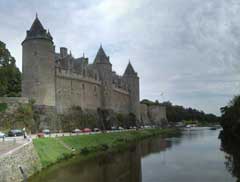 |
Air travel between European cities can be surprisingly cheap, although the $20 headline prices advertised by the likes of Ryanair and Easyjet bulk up a bit after adding the usual fees and taxes.
As a group of holidaymakers [not all of whom shared an infatuation with things boat-related] we found no difficulty in keeping all the members of the party amused. What follows perhaps veers dangerously close to being one of those "What I did on my summer vacation" essays we were forced to write on returning to school in the autumn, but hopefully it gives a flavour of the place and the kind of 'boaty' encounters awaiting the traveller.
Approaching the ancient walled port town of St Malo we passed the entry to several docks and basins. Where I would have expected a swing bridge or perhaps a lifting deck we saw the sliding roadway shown below. When a boat needs in or out of the basins a siren sounds, and the entire road slides back on rails!
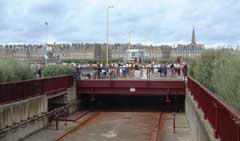 |
The 'bridge' leading to the walled city of St Malo at the mouth of the River Rance. |
A first glance suggested the usual host of production cruisers, the reality turned out to be subtly different. As we walked in towards the town we passed boats with evidence of creative spirits at work:
| Sinbad was the boat's name, the namesake 'figurehead' a little undignified wearing the masking tape of a partly completed refinishing job. |
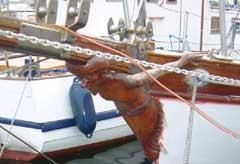 |
Just past the moored sailing dredger "Fleur de Mai" [now a 'floating heritage site'] we saw this:
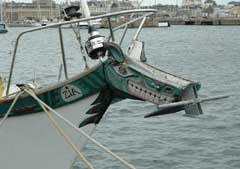 |
Giving a whole new meaning to the expression "with a bone in her teeth." |
Just about everywhere you look on a map of Brittany, little rivers fissure the coast, winding in to tidal basins. Small towns grew up around these havens. Here's a panorama of such a basin at Auray on Brittany's southern coast.

With the tide this far out, the 'legs' commonly used to keep boats upright on their drying moorings are clearly seen. Auray of course is the home of the 'Auray punt', as noted by Claude Worth, redrawn by Phil Bolger, and later miniaturised by Hannu Vartiala.
| It's a punt, and it was the only one we saw at Auray, so I'm calling it an Auray punt. |
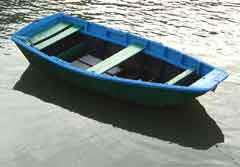 |
Many of the boats we saw were of traditional construction, and showed signs of being kept afloat on a limited budget.
 |
Tabernacles suggested a familiarity with bridges like the one where the river entered the basin." |
Every year a motley collection of boats and their enthusiastic crews take part in a 'raid' style gathering called the 'Route de Cidre' - a semi-formal race and regatta. We caught up with them at the little town of Dinan, near the limits of navigation on the River Rance. Dinan itself is charming walled town.
| Climbing a cobbled lane from the quayside we reached the gate in the walls. The street was steep enough to justify handrails, and the old town's primary means of defence may have been exhaustion on the part of the attackers. Much of the old town is very well preserved - the timberframes are original. |
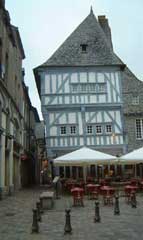 |
While we admired the view from the walls and refreshed ourselves with the local buckwheat crepes and a glass of cider, the quayside was filling up with the 'piratical' crews.
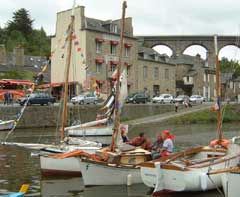 |
Red headscarves and stripey Breton shirts were everywhere. The viaduct seen in the background here was as far below the town walls as it was above the quay! |
Long bowsprits such as these were the rule rather than the exception. A second glance at the boat stern-to in the picture above shows a freeboard which I found startling. The hull really is of the proportions seen here - that's no trick of the camera.
| Another fairly typical example. Husky hullform, and more than a little rough 'around the edges' but being enthusiastically sailed around some rugged coastline. |
 |
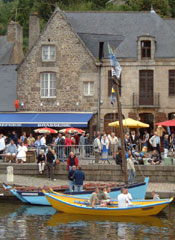 |
With their tombstone transoms and easy rowing lines, these bright yellow hulls made me think 'Dory'. The name of the blue boat translated to something like "Family Support". It wasn't clear whether that was the boat's function, or an explanation of where the resources had gone. |
Most of the boats taking part in the 'Route de Cidre' were fairly small open craft. La Pauline was the obvious exception.
| At a little over thirty feet LOD, she displaces over 11 metric tonnes. Drawn by Francois Vivier, she is a 'Chaloupe' with a lug-sailed schooner rig. Everything about her looked purposeful and substantial. Tiller steering, but notably rigged with relieving tackles. |
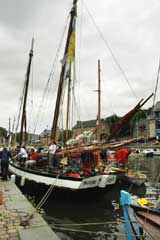 |
|
Bearing marks indicating a home port of Concarneau, this looked to me like a replica 'misainier'. The brailed tanbark lugsail combined with the bluff bow and long raking transom stern are what I think of as the typical inshore fishing boat from the age of sail from this part of the world. |
By far the majority of the small boats we saw had bowsprits, often long ones, and considerable thought had clearly gone into making them easy to tuck away in the tight harbours.
| Some of the 'sprits housed by sliding back inboard, but many more were designed to fold up alongside the mast. The green boat here shows a popular configuration. |
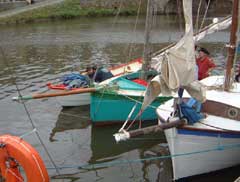 |
A simple rope bobstay is fixed at the end of the bowsprit, and passes under a stout wooden cleat attached low on the stem. From there the rope comes up and is made off on another cleat, this one on top of the inboard end of the 'sprit. The very aftmost end of the bowsprit can pivot on a bolt which connects it to a samson post. When the 'sprit needs to be housed, the inboard end of the stay is loosed and the sprit can be swung up out of the way. Cheap & effective.
 |
As afternoon turned into evening the sailors found their way ashore and what promised to be a long evening's partying started. |
If you find yourself in Europe, either on business or for pleasure, whether you are able to time your visit to coincide with the big maritime festivals or not, I hope that these notes encourage you to seek out and enjoy the still-vivid maritime culture. Perhaps there's some nearer home than that? Where there's water, there's something 'boaty' waiting to be discovered... Why not write in and tell Chuck and the rest of us about it? |

